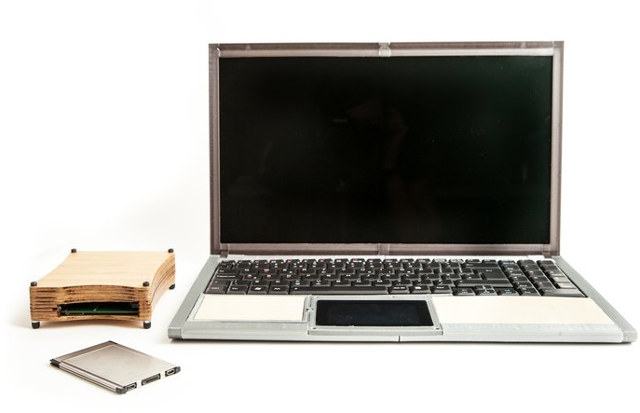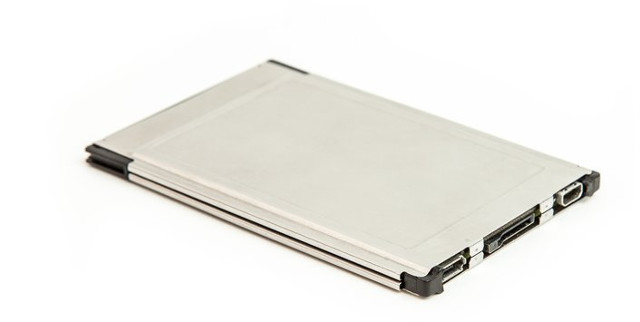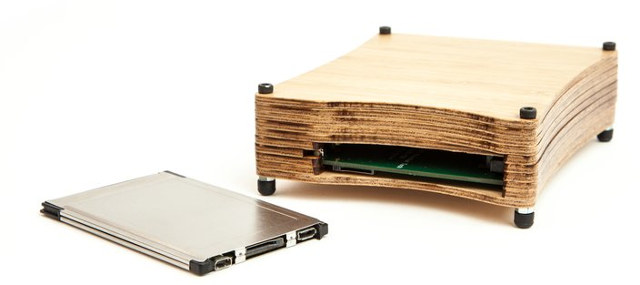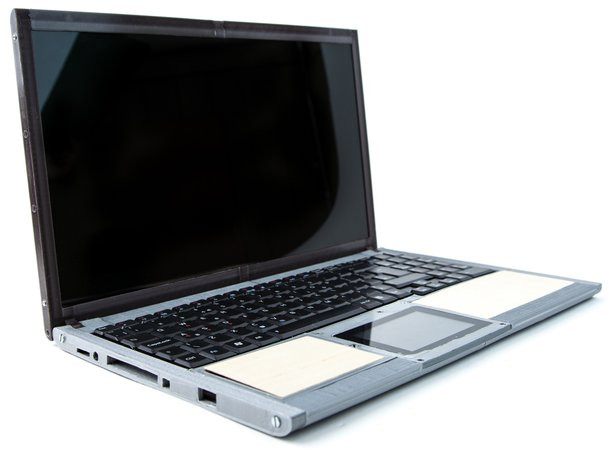Rhombus Tech has been working on EOMA68 standard for CPU modules based on PCMCIA at least since 2012, and after previous difficulties, they showcased a laptop prototype taking OEMA68 CPU cards at the beginning of the year, and they’ve now launched a CrowdSupply campaign selling an EOMA68 CPU card based on Allwinner A20 processor, as well as corresponding laptop and micro desktop housings that are both open source, and upgradeable with faster EOMA68 CPU card once/if they become available.
 Current EOMA68 CPU card specifications:
Current EOMA68 CPU card specifications:
- SoC – Allwinner A20 dual core ARM Cortex A7 processor @ 1.2 GHz with Mali-400MP2 GPU
- System Memory – 2GB RAM
- Storage – 8GB NAND flash + micro SD slot
- Video Output – micro HDMI Interface (for 2nd monitor)
- USB – micro USB OTG port
- Compliant with EOMA68 standard
 Two versions of the CPU card are offered with different pre-installed firmware:
Two versions of the CPU card are offered with different pre-installed firmware:
- “Libre Tea Computer Card” with Parabola GNU/Linux-libre Operating System and a Respects Your Freedom (RYF) hardware product certification from the Free Software Foundation (application in progress)
- “Practically Perfect Computer Card” with Debian and some close-source binary blobs for GPU drivers for example
 While you could use the CPU card by itself by powering it via micro USB port, connecting it an HDMI display, and adding USB keyboard and mouse through a USB hub, you may still want to get a housing such as the micro desktop:
While you could use the CPU card by itself by powering it via micro USB port, connecting it an HDMI display, and adding USB keyboard and mouse through a USB hub, you may still want to get a housing such as the micro desktop:
- EOMA68 Computer Card slot (user-upgradeable)
- Video Output – VGA port (micro HDMI is also available on CPU card)
- USB – 2x USB 2.0 ports
- Storage – One extra micro SD slot on board
- Power – 7 – 21 V DC via 5.5 power barrel
- Dimensions – 11.43 x 11.43 x 1.27 cm (laser-cut wooden case)
 The 3D printed laptop housing is also another option:
The 3D printed laptop housing is also another option:
- EOMA68 Computer Card slot (user-upgradeable)
- Display – 15.6” 1366 x 768 LCD
- Full-sized QWERTY Keyboard including numberpad
- 4.3” capacitive touch panel and backlit LCD
- Storage – 1x micro SD slot up to 256GB (on top of the one in the CPU card)
- USB – 3x USB 2.0 ports (2 internal, 1 external)
- Audio – 1W Stereo speakers, built-in Mic, CM108AH USB Audio with stereo headphone jack
- MCU – STM32F072 Embedded Controller with firmware under GPLv3 license
- Battery – 10,000 mAh good for 6 to 8 hours
- Weight – 1.1 kg weight
The full schematics, and 3D printer design files will be made available. There’s are also plywood panels on both sides of the capacitive touch screen.
The project appears to have two main goals which are not met by most products today: First providing a fully open source system without any closed-source binary blobs, and make computer systems that both earth-friendly as the user-serviceable CPU cards are supposed to reduce e-waste, and cost-saving to the end user as they only need to change the CPU card to get a faster device.
While both ideas are noble, but there are challenges. With Allwinner A20 processor going fully open source using Parabola Linux means that although hardware video decoding should work with the open source Cedrus implementation, you’ll lose 3D GPU acceleration at least, and most WiFi dongles will probably not work either. The Debian image won’t have this problem, but it’s not 100% open source. The idea of keeping the housing for main years, and only changing the CPU card is good, but hard to implement, as what may be acceptable today, may not be in the future. For example the display for the laptop is limited to 1366×768 resolution, and I already know many people who would not this resolution for a laptop, and in a few years the perception is likely to be worse. EOMA68 standards supports USB 1.x to USB 3.x, but both laptop and micro desktop housings appear to be limited to USB 2.0 connectors, so even if you purchase a more powerful CPU card with USB 3.0 interface in a few years, you won’t be able to enjoy the full capabilities of the new card. One solution would be to provide spare parts to repair or upgrade the laptop case, and that’s certainly possibly since the laptop is also designed to be easy assembled by yourself.
Rhombus Tech aims to raise at least $150,000 to fund mass-production for the project. The CPU card goes for $65, the micro desktop housing for $55, and the laptop housing for $500 with other various DIY or full kit rewards also offered. Shipping is free to the US, and adds $10 to $80 to the rest of the world depending on the chosen rewards.

Jean-Luc started CNX Software in 2010 as a part-time endeavor, before quitting his job as a software engineering manager, and starting to write daily news, and reviews full time later in 2011.
Support CNX Software! Donate via cryptocurrencies, become a Patron on Patreon, or purchase goods on Amazon or Aliexpress





agreed, usb 2 and display resolution is a showstopper.
also, why on earth you need numpad and keyboard with very limited space?
I think that those select who neeed it shoud just plug in some external usb numpad.
If they would offer something more powerful I would certanly support them, a20 are you kidding me?
This may be the first time that I back a project via crowdfunding.
Good intentions, terrible execution.
Just a small thing like they fact that they use raw NAND flash rather than eMMC is going to cause a lot of problems. It’s not easy to work with NAND flash and if they haven’t developed a good error correction and wear leveling algorithm, they’re going to end up with a lot of RMA’s.
Is it feasible to make a 1.1Kg laptop with a 15.6inch display?
@cnxsoft
‘you’ll lose 2D/3D GPU acceleration at least’ is not true for A20, please read from here on: http://linux-sunxi.org/User:Rellla/Armbian#xf85-video-fbturbo
@tkaiser
AFAIK this still requires the closed-source userspace Mali drivers @ https://github.com/linux-sunxi/sunxi-mali-proprietary/tree/master, so this will be not included in the FSF approved image.
@cnxsoft
I really don’t get why people are talking about this Mali stuff all the time. 🙂
2D acceleration is provided by xf86-video-fbturbo, 3D stuff might help window managers (or simply use more primitive ones or turn transparency features off) and then irrelevant OpenGLES benchmarks and games remain that might ‘need’ Mali400 acceleration. Which ‘real world’ applications do make use of OpenGLES acceleration? I only know of Chromium but that needs driver version 4.1 or above which isn’t available for Mali400 anyway. Did I miss something?
Running a desktop Linux on this device might be PITA anyway depending on random IO speed of the used SD card or NAND (most probably extremely slow)
@tkaiser
Things like WebGL use 3D graphics.
So I guess we can say open source 2D graphics acceleration should be available, but not 3D graphics.
@cnxsoft
I know that there is WebGL. But which browser is able to use Mali400 accelerated WebGL? None to my knowledge. The last time I did some research I found only people talking about Chromium on armhf would benefit the most or at all from OpenGLES acceleration. But Chromium seems to need at least r4p1 for that and all we have for Mali400 are binary blobs up to r4p0 –> no accelerated WebGL anyway.
So if you don’t use a window manager that makes use of compositing / transparency (where OpenGLES would help) or are a (retro-)gamer or are happy looking at useless OpenGLES benchmarks… what’s Mali400 3D acceleration for at all?
And as already said: browsers that might support WebGL have always a couple of databases open and on devices like the one we’re talking here about this will be horribly slow due to low random write IO performance (SD cards or NAND). The most interesting feature of A20 in this regard (SATA 2.0 capable and implementing native command queuing which could’ve be combined with a mSATA SSD) isn’t used with this concept — for obvious reasons.
@tkaiser
WebGL works in Radxa Rock using Firefox OS, I’m not sure that means it should also work with Firefox browser though -> http://www.cnx-software.com/2014/12/24/webgl-demos-in-radxa-rock-pro-board-running-firefox-os-2-1/
@cnxsoft
According to your own link: ‘Firefox OS shares lower part of Android. GPU/VPU/etc should work. (if porting work is done well, of course)’. Anyway: My initial comment targeted A20 in general. I wouldn’t use any of these small devices running a desktop Linux or Android when they have to run off ultra slow storage since user experience will suck for sure (random IO and especially writes here matter)
Sure, if you have a tiny battery, no heavy cooling (copper pipes filled with liquid), no fans, no hard drives or optical drives. It won’t weigh much if it’s mostly just a dock for that module.
@Armer
yes it is – it works surprisingly well for being 3D printed. the screen is 400g in weight, the battery is 240g and takes up the entire left hand side, it’s 10Ah so is 40Wh – it’s actually an E-Bike battery 🙂 – so is good for 8-10 hours (this is a 15in laptop remember!)
so with no fans, no bits of metal (no heat-sinks) because this computer card is only 3.5 watts it’s all passively-cooled, and no HDD, it’s very light-weight, the PLA from faberdashery is really strong, but not stressed out because of the greatly reduced weight.
i was thinking i would need to use PTFE, nylon or PolyCarbonate but it turns out that PLA is pretty damn good.
@tkaiser
thumbs-up cnxsoft, yeah basically i’ve just done a video showing libreoffice running, being moved around the screen, it’s pretty snappy: no tearing, i just got xf86-driver-fbturbo compiled up to use G2D and y’know what? it’s pretty good.
update with video will be live soon.
you bet it won’t! anyone who wants to add it, they can do so, we’re not going to stop anyone (we couldn’t if we wanted to!) so feel free… but yeah we won’t be including mali.
we _will_ however be including g2d fbturbo xorg accelerated drivers.
wow thank you peter, i really appreciate that. thank you
this is a good point, and greatly appreciated. there’s people working on the mtd NAND driver, and i know that ubifs is the usual default filesystem. it’s *designed* to cope with error correction and wear levelling, from what i understand, ubifs is the successor to jffs2 which has been around for a long, long time. also, i’m considering putting in SLC instead of MLC even though it will be more expensive, after learning that even reads can cause corruption of MLC! that sounds like … daft to me.
but, first thing: this is a crowd-funding campaign: it’s not “products”. there’s no contract of sale. by funding us you’d be helping us to achieve the goal of reaching mass-volume with a completely different paradigm in computing appliances. we hope that we’ve done our homework so that you receive *reliable* products, but this is the very early stages just after first prototypes. we do believe we’ve done our homework because we’re using a Reference Design that’s been in use in android tablets for the past three years, with great success!
second thing: the A20 is known as being “unbrickable”. you can *always* boot from external Micro-SD. so if things do go wrong, such that every single one of the multiple places that the A20 internal boot rom reads from (and there are several) is irreversibly corrupted such that the NAND is completely unrecoverable, you can always just put the entire bootloader (u-boot) and OS onto a MicroSD card and run from that.
p.s. i like your question so will be putting it on the FAQ – thank you for asking!
hth,
usb2 is what’s available on $7 SoCs at the kind of level that we can get access to without extreme budgets and signing NDAs. bear in mind that this is an eco-conscious laptop: what on earth kind of message would it send to people if i broke my own ethics by trying to work off a $250,000+ budget, consuming huge amounts of resources in the process? i wouldn’t be able to justify that it’s an eco-conscious project because i would not have lived *by* that ethic.
the display is 15.6in so 1366×768 is surprisingly good. remember this is targetted at average end-users, for office-style work, bit of email, bit of internet access, print some documents, that sort of thing. it’s basically the exact same screen (and i do mean exactly the same) as what you get on those “Budget” laptops at Walmar, Best Buy, Asda and so on – the ones for $USD 300, you know? those LCDs are available in huuuge volume, so people stand a really good chance of being able to buy a replacement off of ebay over the next 3-4 years, and not get ripped off.
but also because it’s running at such a low resolution, and because it’s done in higher geometries, it’s actually extremely cost-effective *and* very low power. i was amazed to learn that you can run it off of under *4* watts if you drop the refresh rate down to around 30hz. that’s including the backlight!
so this means you get really good battery life (out of a 240g E-Bike battery) even though it’s a 15.6in screen.
regarding the keyboard: 15.6in is not limited! it’s a full-sized keyboard, even with the numberpad. that’s enough to do office work comfortably.
basically we’ve put a lot of thought into this, taken a lot of factors into consideration that any other standard manufacturer would simply not do. the trackpad for example is actually a 480×272 LCD with a Capacitive Touchpanel behind it! so you can display buttons on the LCD, and change them to 1, 2 or 3 in the firmware. also you can *display* scrollbars rather than try to guess where they are. play space invaders on it, or display volume control, battery life etc. even when the main laptop’s switched off because the 4.3in LCD is run by a separate EC (an STM32F072).
also, regarding the A20: this is just the *first* in the series. that’s the whole point, that you can upgrade later for $50 a time instead of throwing the whole laptop into landfill, and end up with double the speed, double the RAM and double the storage. i am committed to this project for the next decade at least, so will be bringing out new Computer Cards indefinitely. you’ll always be able to upgrade. and sell the old ones on ebay, where people will gladly take them off your hands and turn them into routers or co-located hosted ultra-low-power servers…
this is exciting stuff man! 🙂
@Luke Kenneth Casson Leighton
here it is – https://www.crowdsupply.com/eoma68/micro-desktop/updates/first-update
@Luke Kenneth Casson Leighton
It’s fine that the card supports USB 2.0 only since that’s the limitation of the processor, but it would have been nice if the micro desktop and laptop boards would have integrated USB 3.x support, as new EOMA68 cards with USB 3.0 could have been used in the future.
That is actually a bunch of good questions to Luke: how about plans for future cards with better processors? Timeline? Which ones? Will there be in general options for (other) hardware upgrades – like for the screen et al?
hiya peter (and cnxsoft) – about USB3 in the housings, i had to keep to a reasonable cost and power budget. the laptop’s PMIC is 15W and it’s single-cell. USB3 is what… 1A per port? USB 3.1 has even 150W provision or something mad? it’s just not practical: i would have had to pull in a huge cascade-effect of extra components (triple or quadruple-cell PMICs, radically different casework design) – it’s a totally different project and i had to make a decision, “what can i achieve NOW with the resources that i have NOW” vs “what could be done LATER if what i can do NOW comes to fruition?”
yes i have some SoCs being evaluated and on the roadmap, remember this is a project that i’m committed to for the next 10 years, having been on it for 5 already. i’m looking at the RK3188 as a quad-core candidate (because thanks to tom cubie’s team, the radxa rock’s PCB CAD files are publicly available), and the A64 as another *IF* allwinner sort out the GPL violations on that processor.
there’s several other strange ones – i really want to put a zynq processor into EOMA68 form-factor. but the next most likely one is the EOMA68-jz4775 which i already have prototypes of that which need testing, the jz4775 is the “grown up” version of the same processor in the Ben Nanonote. we do however need a mipsel OS up and running for it though (not mips64).
lots and lots to do! it takes about $4k to get each CPU Card done, excluding engineering time (around 2-4 months, possibly longer if there’s no Reference Design to work from). so it’s a matter of time and cost, hence why we need *this* campaign off the ground first….
screens with up to 1920×1080 resolution: that will need a 3.3mm height EOMA68 card, which means looking for Type I PCMCIA casework suppliers (or getting them made up), reason being if you have 1920×1080 on the RGB/TTL output, you **MUST NOT** allow 5mm cards (which max out at 1366×768) to be put into 3.3mm base units because they simply won’t work. some of these $3 SoCs, they simply cannot drive LCDs beyond 1366×768, they just don’t have the internal memory bandwidth, and it’s a shared memory bus between video and main processor.
anyway the 3.3mm cards will all need tooling done, so it’s on the long-term roadmap.
anyway what i tell people here is, cards which have an HDMI port, those i usually design the Computer Card so that the HDMI port is out the other end as a 2nd (simultaneous) screen. so the EOMA68-A20 you can do dual monitors, the HDMI one up to 1920×1080.
$50K raised so far. 33% of the goal.
$135K raised (90% raised) with 35 hours to go.
OEMA68 Card / micro Deskop / Laptop project is now fully funded with 22 hours to go.